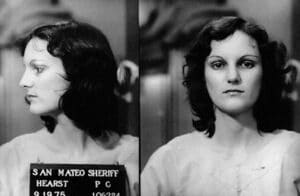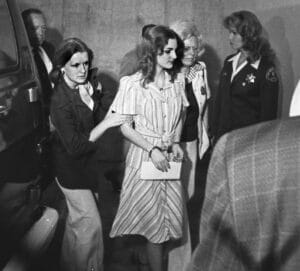During their revolutionary endeavors in 1970s California, the SLA employed guerrilla warfare tactics. Donald DeFreeze founded the SLA, which became known for its violent tactics and anti-establishment beliefs. “Symbionese” was the name created by the group by merging “symbiosis” and “Liberation,” underscoring their belief in communal living and armed resistance.
By assassinating school  superintendent Marcus Foster, the SLA demonstrated their violence. This action, along with others, showed the group’s readiness to employ drastic methods to advance their agenda. The SLA gained national attention for their involvement in the Hibernia Bank robbery in San Francisco, where Patty Hearst, a key figure in the SLA story, was seen participating.

After kidnapping Patty Hearst from her Berkeley apartment, the SLA made headlines in 1974. Hearst was indoctrinated and psychologically manipulated by her abductors, causing her to become “Tania” and supposedly adopt revolutionary beliefs. Hearst’s involvement with the SLA was influenced by coercion and brainwashing, as revealed by this transformation.
Hearst’s involvement in criminal activities planned by the SLA, including the mentioned bank robbery, revealed her changed allegiance. Hearst’s identity and actions during her time with the group were profoundly influenced by the SLA’s tactics, highlighting a shift from victim to perpetrator.
The SLA’s violent campaign went beyond the tragic killing of school superintendent Marcus Foster. After kidnapping newspaper heiress Patricia Hearst, the group caused another shocking incident that gained national attention and increased their infamy. The kidnapping of Hearst not only showcased the audacity of the SLA, but also exposed the lengths they are willing to go to advance their revolutionary agenda, establishing them as a major threat to law enforcement and the public.

Not only limiting their radical actions to high-profile crimes, the SLA also engaged in armed robberies such as the audacious Hibernia Bank heist in San Francisco. Hearst’s involvement in this robbery highlighted the group’s disregard for the law and their willingness to engage in violent confrontations with authorities. The Hibernia Bank robbery’s public spectacle increased the SLA’s notoriety and raised safety concerns for those involved in their criminal activities, intensifying public fear and intrigue with the group’s violent methods.
Exploring not only Patty Hearst’s connection with the SLA but also igniting a wider societal discussion on personal accountability and the influence of coercion was the focus of her trial. Hearst’s involvement with the SLA raised questions about her mental state during the courtroom proceedings. The defense argued that Hearst’s actions were influenced by intense coercion and brainwashing from the SLA. This argument underscored the complexities of the case, blurring the lines between free will and external manipulation.
After being convicted for armed bank robbery, Hearst’s responsibility became the subject of public attention. Additionally, President Jimmy Carter’s choice to commute her sentence brought more controversy, with differing views on whether justice was achieved or if external factors played a role. Patty Hearst’s case exemplified the overlap of legal, ethical, and psychological factors, leading people to reconsider ideas of personal autonomy and moral responsibility when confronted with coercion and manipulation.

The SLA saga had a cultural impact that extended far beyond its immediate timeframe. Numerous books, including “Revolution’s End,” were published to offer a complete narrative of what happened. These literary works retell historical events and offer critical perspectives on the societal circumstances that enabled radical groups to rise, prompting readers to ponder themes of power, manipulation, and individual choice.
Decades later, debates and discussions still arise from the SLA’s revolutionary ideology and Patty Hearst’s controversial involvement, leaving a lasting legacy. Transitioning between victim and perpetrator, Hearst’s intricate actions unsettle conventional ideas of personal accountability and coercion, resulting in ongoing ethical dilemmas and divergent public interpretations. The SLA’s brief but intense venture into American history has had a lasting impact, emphasizing the ongoing significance of its story in modern conversations.
